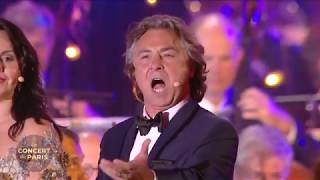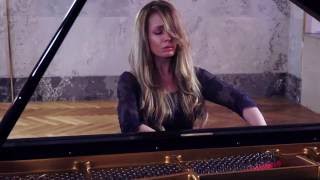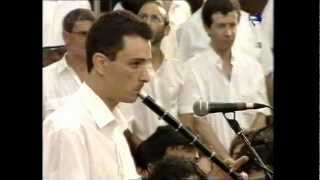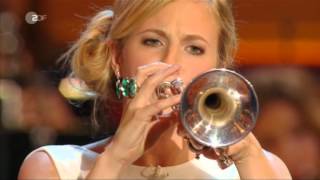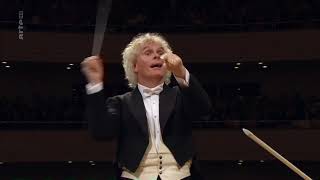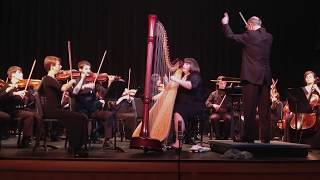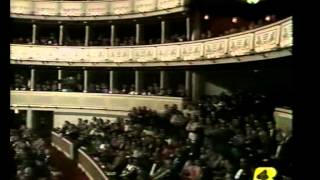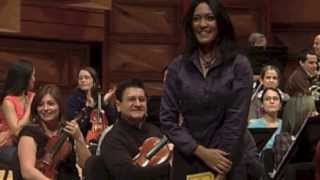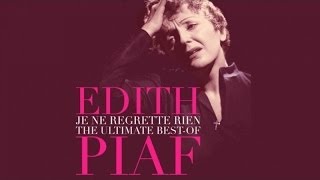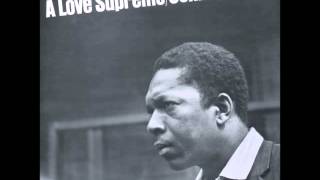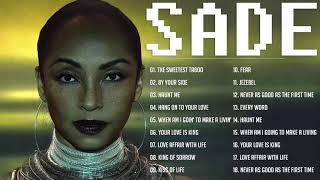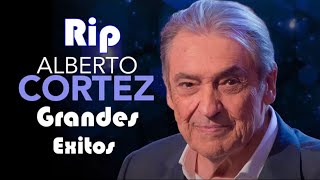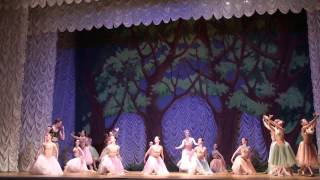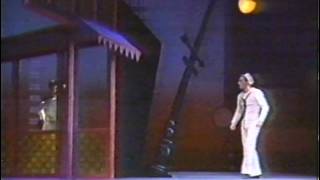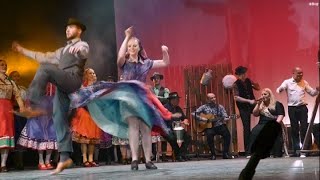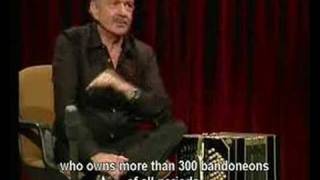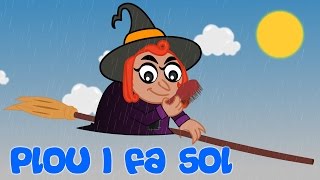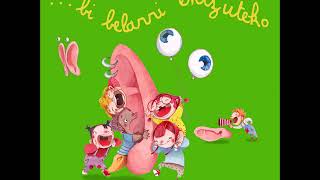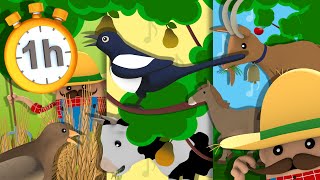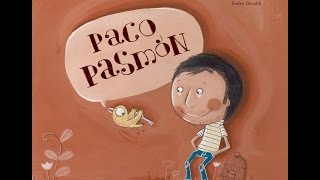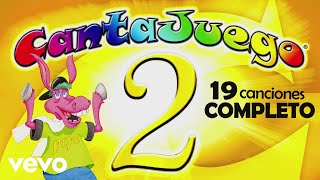France celebrates its National Day on July 14.
Recommended music videos for initiation to classical music
La Marseillaise (“La Marseillaise”) is officially, since July 14, 1795, the national anthem of France . Originally titled Chant de guerre pour l'armée du Rhin ("War Song for the Army of the Rhine"), the hymn was written in 1792 by Claude Joseph Rouget de Lisle , captain of engineers in the Strasbourg garrison, as a patriotic song of revolutionary France in its war against Austria. Parisians welcomed it with great enthusiasm and christened it La Marseillaise . It was prohibited during the Empire and the Restoration and became official again in the Third Republic . During 1940-1945 he was again banned, and his singing was considered a symbol of resistance to the German occupation and the collaborationist Vichy regime.
The Anthem from the moment of its creation, appears associated with the fight against tyranny. Today we will see it in an orchestration by Hector Berlioz performed by the splendid French tenor Roberto Alagna .
Frédéric Chopin (1810-1849) was a virtuoso Polish pianist and composer; as a pianist, he is considered one of the most important in history and as a composer, one of the benchmarks of Romanticism . He was born into a vocationally musical family; his mother played the piano and his father the violin and flute; His first teacher was a sister of his with whom he liked to play pieces with four hands. At the age of eight he gave his first public concert in the palace of the Radziwill family in Warsaw . Chopin 's work focuses exclusively on the piano, solo or concertante, with which he embarked on a solo career of technical perfection, expressive splendor and deepening in the rubato until he became the musical benchmark for that instrument.
Anastasia Huppmann (1988) is a Russian pianist born in Tver who began her piano studies at the age of five; at the age of six she was treated as gifted, delving into the studies of music theory, piano and composition; At seven, he appeared on television playing his own compositions and at eight, he won his first piano competition, which, throughout his career, would be followed by a few more, which has earned him performances in the most important venues in Europe . and Asia . Today he offers us the Fantasia-Impromptu, op 66 in C sharp minor by Chopin
The Txistu belongs to the European family commonly known as "Three-hole flute". It is played with only one hand (usually the left), so that the other is free to play the drum that hangs from the arm used to play the txistu (currently tuned in F). The whistle or txistu haundi , a deeper instrument, tuned in Bb , and the txirula , a higher-pitched instrument, which is usually accompanied by the ttun ttun (string drum), belong to the same family. The txistu is used in pilgrimages, parades, tributes, institutional acts and in different types of concerts both as a solo instrument accompanied by an orchestra, and as part of a txistus band , which perform works written for three voices (txistu 1st, txistu 2nd and whistle) with accompaniment by the drum and the snare drum.
Donostiako hiru damatxo is a popular Basque song by an unknown author that has been arranged by different composers for groups of different colors. The version that we offer today for solo txistu is the work of José Ignacio Ansorena , professor of Txistu at the Conservatory of San Sebastián , and stars Alfonso Iturria as solo txistulari accompanied by a guitar, a txistu orchestra and a choir of voices mixed conducted by the author of the musical arrangement.
Johann Nepomuk Hummel (1778-1837) was an Austro-Hungarian virtuoso pianist, composer, teacher, and conductor, considered one of the greatest composers and pianists of his day. In 1786, at the age of eight, the family moved to Vienna , becoming a student of Mozart. In 1819 he accepted the position of Kapellmeister in Weimar , a position he held until his death in 1837. As a composer, Hummel stands on the border between classicism and romanticism and his work spanned all genres of the turn of the century: operas, singspiele, masses. symphonies, works of sacred music, chamber music, concertos, songs and music for solo piano.
The trumpet is a musical instrument that belongs to the brass family . The sound is produced thanks to the vibration of the performer's lips in the part called the mouthpiece from the air column (air flow) of the performer. The trumpet has three pistons that direct the sound through different parts of the tube that forms the instrument and thus lengthen or shorten the path of the sound. In addition, the trumpeter can select the execution of a range of harmonics by modifying the opening and tension of the lip exerted on the mouthpiece. The basic range of the trumpet has an extension of two and a half octaves, although currently the register increases to three octaves.
Alison Balsom (1978) is an English trumpeter who in 2009 performed as a soloist at the London Proms and in 2013 was named Artist of the Year by the Gramophone Awards . She has been awarded honorary doctorates from the University of Leicester and Anglia Ruskin University and is an Honorary Member of the Guildhall School of Music and Drama . Today he offers us the third movement of Hummel 's Trumpet Concerto .
Recommended classical music videos
Claude Debussy (1862-1918) was a French composer considered to be the first composer of Impressionism . In 1884, with the cantata L'enfant prodigue, he won France 's most prestigious musical award, the Prix de Rome . Back in Paris , he was impressed by Wagner 's opera Tristan and Isolde , “the best I have ever heard”. Later he would be influenced by the structures of Javanese music, by the harmonic freedom of Rimski-Korsakov and by Erik Satie , similar to his approaches. In 1894 he premiered his Prélude à l'après-midi d'un faune ; four years later is when he achieved his international fame with his only finished opera Pelléas et Mélisande ; he was then 37 years old. Today Debussy is considered one of the most important composers of the 20th century .
Jeux (Games) is a ballet written by Claude Debussy . Described as a "danced poem", it was written for Diaghilev 's Ballets Russes . Jeux premiered on May 15, 1913 at the Théâtre des Champs-Élysées in Paris , under the direction of Pierre Monteux . The play was not well received and was soon overshadowed by Stravinsky 's The Rite of Spring , which was released two weeks later. There are around sixty different tempo markings in the work, enough for Émile Vuillermoz to describe the score as changing "speed and nuance every two bars". Jeux 's thematic motifs are similarly very short, often two bars long or built from two single-bar building blocks.
Georg Friedrich Handel ( 1685-1759) born in Halle , Germany, is one of the leading figures in the History of Music and, of course, of the Baroque (1600-1750). He wrote numerous operas, cantatas and oratorios, among which we must highlight his masterpiece, the Oratorio El Mesías . At the age of 18 he moved to Hamburg where he joined the Opera Orchestra . After three years, he traveled to Florence and then to Rome . In 1710 he returned to Germany and from there to London where he settled under the tutelage of different patrons. Although he was always very jealous of his private life, there are innumerable indications that make us assume his homosexual inclination. In London he acquired his British nationality and was appointed manager of the Opera House until his death in 1759.
Handel 's Harp Concerto was published as an organ concerto in Opus 4 in 1738, and may have originally been composed in that form. In fact, as published, the Concerto works on both instruments. Handel 's organ concertos were written as interludes for him to play during his oratorios, on the organ he had available at the theatre, a chamber organ with a keyboard and no pedal board, so they do not include a part to be played with the feet in addition to the right and left hands. (Excerpted and translated from the article by The Phil of the Los Angeles Philharmonic ).
It is structured in three movements: I (0´29´´)ANDANTE-ALLEGRO .-. II (5'02'') LARGHETTO with the CADENZA (8'50'') at the end of the 2nd movement (rare at that time) and III (12'26'') ALLEGRO MODERATO and performed by the very young (she had then 17 years old) Morgan Mackenzie Short .
Umberto Giordano (1867 - 1948) was an Italian composer dedicated mainly to the creation of operas. His best-known work is Andrea Chénier , a verista-style romantic opera composed at the end of the 19th century . He was born in Foggia , Italy, and despite his father's opposition enrolled at the Naples Conservatory in 1882. He was a student of Paolo Serrao and wrote his first opera, Marina, for an academic competition. Later he wrote Mala Vita . Later he tried a more romantic approach with his next opera Regina Diaz (1894); but this was a failure. He then tried his luck in Milan , again with a verista theme, with his best known work, Andrea Chénier (1896) which was, and still is, a success. His later work is less well known.
Verismo appears as a literary trend that emerged between 1875 and 1896 in Italy to refer to a type of characters, situations and real emotions, characterized by its sordid plots. In the world of opera, verismo is associated with composers such as Pietro Mascagni, Ruggero Leoncavallo, Umberto Giordano and Giacomo Puccini , who advocated bringing naturalism to opera.
Andrea Chénier is a verista opera with a historical setting with music by Umberto Giordano and a libretto in Italian by Luigi Illica , loosely based on the life of the French poet André Chénier (1762-1794), who was executed during the French Revolution . Premiered at La Scala in Milan on March 28, 1896, it is currently the composer's most famous opera. During the first half of the 20th century it was produced with some frequency and entered the standard operatic repertoire. One of the reasons that contributed to its popularity was the splendid lyrical-dramatic music of the main tenor, which provides a talented singer with many opportunities to shine on stage.
Paul Hindemith (1895-1963) was a prolific German violinist and composer who wrote for all musical genres. He studied violin, composition and conducting at the Frankfurt Conservatory . In 1915 he was admitted as a violinist at the Frankfurt Opera and in 1917, appointed concertmaster. Meanwhile, he premiered different works that earned him the appointment of composition professor at the Berlin School of Music. His musical style goes through different trends of all styles; although, in his last years, he was profoundly opposed to the new tendencies of dodecaphonism and, above all, of integral serialism . Its influence in the first half of the 20th century was notable, although after the Second World War it was surpassed by the Vienna School .
The Symphonic Metamorphosis of Themes by Carl Maria von Weber is a suite divided into four movements composed at the suggestion of the ballerina Léonide Massine , who suggested to him the idea of arranging Weber 's music for a ballet.
Today we will watch his second movement under the direction of Victoria Sánchez (1986), a Venezuelan pianist and conductor who emerged from the National System of Youth and Children's Orchestras of Venezuela, into which he entered at the age of nine after studying for a few years at the Simón Bolívar Conservatory of Music. . Sometimes as a pianist and other times as a conductor, she has performed in Venezuela, Mexico, Germany, Spain, the Netherlands, Russia, the Czech Republic, Italy, England, Norway, China and South Korea . He currently combines management with musical direction and teaching at the Nucleo La Vega - Carlos Delfino Foundation belonging to the System of Orchestras of Venezuela
Recommended music videos for all tastes
Édith Piaf (1915-1963) is the artistic name of Édith Giovanna Gassion , one of the most famous French singers of the 20th century , to whom numerous songs from the French-speaking repertoire are owed, such as "La vie en rose", "Non, je ne regrette rien», «Hymne à l'amour», «Mon légionnaire», «La Foule» or «Milord», known worldwide. A prominent personality, Piaf inspired numerous composers and mentored young artists who achieved international fame. Édith Piaf also stood out as a film and theater actress, participating in numerous films and plays. In the 1950s Édith , famous in many countries, became something of a Parisian icon. The North American public enshrined it in 1956 at Carnegie Hall in New York , to which it returned frequently,
John Coltrane (1926-1967), was an American jazz musician, tenor and soprano saxophonist, and occasionally alto sax and flute ; He is one of the most relevant and influential musicians in the history of jazz , on a par with other artists such as Louis Armstrong, Duke Ellington, Charlie Parker and Miles Davis . He married, for a second time, the jazz pianist Alice Coltrane (1937-2007). His musical career was marked by constant creativity and always within the avant-garde, covering the main styles of jazz after bop : hard bop, free jazz and modal jazz . Coltrane's work is consciously linked to the fight for black civil rights and, on many occasions, towards a transcendence as can be seen in what is considered his masterpiece, A Love Supreme .
Sade , is a British nationalized Nigerian singer and songwriter. With a British mother and a Nigerian father, at the age of four he went with his mother to live in England when she separated from him. During his adolescence he did not stop listening to records by Nina Simone, Peggy Lee and Astrud Gilberto . At that time, she wasn't thinking about singing yet, but about studying fashion at the Saint Martin college, and she only decided to present herself as a vocalist when a couple of old college friends created a group "until they find a singer." In a short time she became one of the few artists to have appeared on the cover of Time magazine. In 2002, she was awarded the Order of the British Empire , in recognition of her artistic achievements and her defense of the values that sustain society.
Alberto Cortez (1940-2019) He was an Argentine singer-songwriter born in La Pampa . As a child he received piano lessons that would create his attachment to music and the piano in particular, which would accompany him in his public performances. In 1960, to avoid military service, he moved to Spain , performing for the first time at the Teatro La Zarzuela in Madrid, where he would reside during his lifetime. He was a great friend of Facundo Cabral with whom he performed on several occasions and with whom he recorded four albums and made successful tours of Latin America ; He also collaborated with Mª Dolores Pradera, Mercedes Sosa , Joan Manuel Serrat and other renowned artists. He died in Móstoles , Madrid, at the age of 79.
Recommended peculiar videos
La Péri is a one-act ballet to music by French composer Paul Dukas , originally choreographed by Ivan Clustine and premiered in Paris in 1912. Iskender (the Persian name for Alexander the Great ) while trying to find the secret of immortality comes across a Peri (divinity, kind of fairy, from Persian mythology). Indeed, at the end of his youth and after noting that the star of the Magi had vanished, Iskender travels throughout Iran in search of the Flower of Immortality . After three years of searching, Iskender finds a Peri carrying the Flower of Immortality which he steals from her while she sleeps. The style of his music can be described as a mixture of romantic tonal harmony with orchestration techniques close to impressionism.
Fancy Free is a ballet by Jerome Robbins , with a score by Leonard Bernstein , set design by Oliver Smith , costumes by Kermit Love , and lighting by Ronald Bates . The premiere took place on Tuesday, April 18, 1944, at the former Metropolitan Opera House in New York . Fancy Free was the inspiration for a hit musical, On the Town , and a portion of the score was also used in the opening scenes of Alfred Hitchcock 's Rear Window . The scene is in a bar and outside sidewalk in wartime New York City. Three sailors on the loose arrive noisily, have a drink (two of them trick the third into paying) and head outside in search of female company, which causes various incidents of a different nature.
The interpretation is provided by the New York City Ballet.
Gypsy dance is the expression of a people called gypsy whose origin is a great unknown for historians. Who are the gypsies? The most widely accepted theory is that the gypsy people are a group of tribes native to northern India that migrated by different routes and at different times until they reached Turkey , where they divided into two migratory streams, one towards Europe in the direction of Spain and the other. others through the Maghreb reaching Andalusia . Gypsy dances were taking shape in that period throughout the migratory process. It even came to Latin America much later in a subsequent migration. Gypsy dance is generally associated with that of Eastern Europe or with flamenco , but there are many other gypsy dances in Turkey, Russia (Balkans), Macedonia and even in the Arab Countries .
Features . If we consider its origin in North India , part of the Kathak dance (from the Mongolian period) and Kalbelia (that of the snake charmers) are a dance where one turns and works with the soles of the feet in a kind of tapping . barefoot Another peculiarity could be their musical expressiveness: they work rhythmically with syncopation, foot-stomping, clapping and body percussion, which is something that is also transferred to flamenco. ( Extracted from the article by Gabriel Vaudagna Arango in the Balletin Dance Magazine )
Ástor Piazzolla (1921–1992) was born in Mar de Plata , Argentina; At the age of three he moved with his family to New York where his father bought him a bandoneon. At the age of thirteen, he contacted Carlos Gardel and the secrets of tango. On his return to Argentina , for six years he received classes from Ginastera and was part of different formations, from where his innovations were considered as the murder of tango. In Paris , however, he contacted Nadia Boulanger who made him believe in the possible conjunction of tango with classical music. He returned to Buenos Aires with such activity that in 1973 he suffered a heart attack; despite what he continued with his activity until in 1990 he suffered a thrombosis in Paris that he would not be able to overcome.
Today maestro Piazzola talks about the bandoneon.
Recommended music videos for children
Various Wikipedia articles have been used to write these texts.
The texts of Videomusicalis are written in Basque, Spanish and English.





